In The Garden: Growing Pineapples in the Sub Tropics
Here on the Treasure Coast pineapple production has had a long and not always happy history. Back in the late 19th and early 20th centuries pineapple plantations on the Treasure Coast were doing big business, shipping hundreds of thousands of boxes north every summer, first by boat, and then later via the Flagler railroad. Various slings and arrows of outrageous fortune crashed the pineapple industry here, and many plantations switched to citrus production, leaving pineapple production to other states and Florida gardeners.
Today, I have hundreds of pineapple plants in my Fort Pierce food forest. They are one of the most effortless and fruitful crops I have had the pleasure of growing. If you can grow bromeliads, you can grow pineapples. During garden tours, people often tell me that their pineapple plants are smaller than mine and don’t produce well.
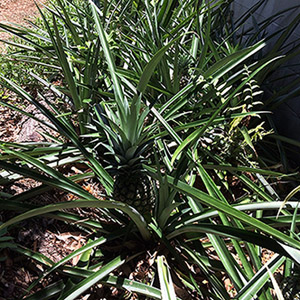
Certain pineapple varieties can be smaller than others, but varieties aside, you can’t get big juicy pineapples off of small struggling plants. I have tried many different soil amendments on pineapples over the years, including doing absolutely nothing for them. Even that works for a year or two.
Before I go into my easy methods for keeping pineapples healthy and productive, I want to explain what a pineapple plant is. Pineapple plants are bromeliads. Some bromeliads are epiphytes growing attached to trees without any soil contact. Others require soil contact. Pineapples are generally grown in the soil. They can grow in full sun, and even in deep shade, but they need at least filtered sun to produce flowers and fruit. In my yard, the preferred location for pineapples is in partial shade. They are good guild members, gladly growing below open woody dwarf tress and on edges near bushes. They are only shallowly rooted, so they are easy to move into new locations. And they seem to love being in a crowd of other pineapple plants.
While there are several different varieties of Pineapples, the majority of plants in my landscape are likely types that are commonly sold in grocery stores in the US, having come from pineapple tops acquired from various friends and grocers who were discarding them post pineapple consumption or processing.
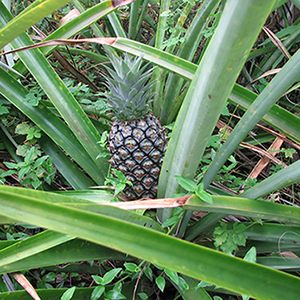
Pineapples like other bromeliads produce just one flower/fruit and then die off. Often people don’t even see it happen because one pineapple mother plant will, in addition to fruiting, throw off a few pups before she is done. When she dies off, her pups fill in her space and more, and her dying leaves slip down to the soil, and her ending goes unnoticed. The pups from that pineapple plant will fruit the next year. They are attached to a dense root stalk, and so grow very quickly. When pineapple fruit is ripe enough to eat, the top can be twisted off, and planted in the ground. In two years that pineapple top will produce fruit, and have some pups. Sometimes pups will start to grow on the pineapple stalk at the base of the pineapple fruit. They are so prolific, you can see why I have 100’s of pineapples.
Years ago, here in St. Lucie County Florida, we didn’t talk about a plant without discussing it’s cold hardiness. Pineapple plants are cold tender. According to Charles Boning in Florida’s Best Fruiting Plants, “The pineapple will usually survive a temperature drop to 29 degrees F. However, a temperature drop to 27 F will often prove fatal.”
Keeping pineapple plants healthy and fruiting is pretty easy. It is important to remind new readers that although I have big patches of pineapples, I have them mixed with myriad other plants, and throughout the landscape rather than isolated or mono-cropped. They are even left most of the season to team up with various wild plants that may crop up amongst them. There is, however, no St. Augustine grass growing with my pineapples. I don’t think the pineapples could successfully compete with that.
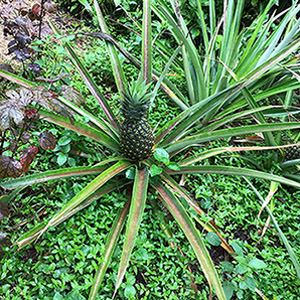
Pineapple plants like to be mulched. The mulch I prefer to use is the mulch the tree trimming company Asplundh makes. Because it has green leaves and green wood ground up in it, it works very differently than bagged wood mulch from the store. I usually let the mulch sit for a month after it’s delivered before serving it to pineapple plants.
In the past I have collected seaweed for my pineapple plants. Some people rinse their seaweed, some people don’t. I guess it matters where you are gathering it from. If it is washing up on the beach it may not have much sand in it, and it is covered in great ocean water minerals. If it has been sitting in the dry sand for a long time then it will have a lot of sand collected in it. I don’t much bother with rinsing, but I put my seaweed into a large planter bucket, and it is likely to be rained on before I get around to mulching my pineapple plants with it. You might chose to avoid gathering from the ocean as I did this year due to blue green algae and red tide issues. The pineapples can live without seaweed.
My favorite pineapple planting method is to place a cut log, palm, oak, or pine, it doesn’t matter which, upright with a planting of four or five pineapple plants around it. The bigger the circumference of the log, the more pineapples will fit around it. Then I mulch the soil around the log and the pineapples, and place another log, rinse, repeat.
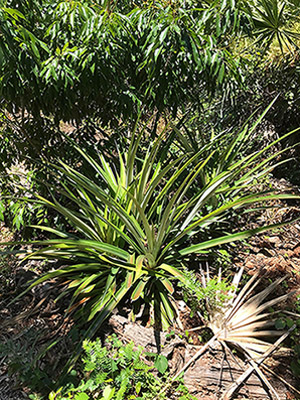
Pineappples growing next to my blueberry plants were in deep pine mulch surrounded by pine logs. Those grew huge. The blueberry plants… don’t ask.
If I leave my pineapples to ripen on the plant I lose a large percentage of my potential harvest to opossums who believe a pineapple is ready to eat far sooner than I do. Therefore, once a pineapple begins to change from green to yellow or orange I harvest it then and let it ripen indoors. To harvest a pineapple I hold the fruit in my hand and snap it off of the stem, sometimes a slight twist helps the pineapple to pop off the plant.
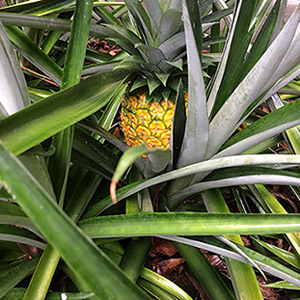
A pineapple is ready to eat when it has no green color left on it, and it has a sweet smell. I keep a close eye on ripening pineapples indoors, moving them frequently and checking the place where they come in contact with the counter top.
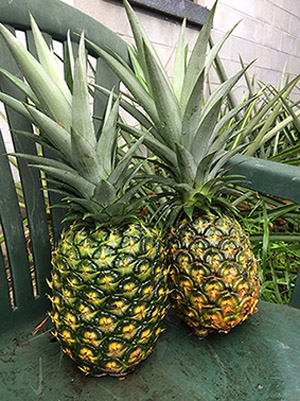
Just Picked Not Yet Ripe 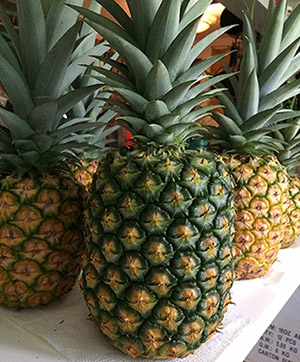
In Various Stages of Ripening Indoors
One final note on my observations about growing pineapples. Most pineapples will flower in February, March, and April. It takes months for the developing fruit to mature and ripen. Each year in my yard, several plants flower and fruit considerably later than May. Those plants will produce large lovely pineapples, but if they are not ready to harvest until short days and cooler temperatures, they will have a low sugar content. They are still juicy, and pineapple flavored, but because of the sugar deficit, they need to be sweetened. And so, serve us better in baking or other fruit desserts that can be sweetened.
Enjoy your pineapples.

9 Responses
I was just eating fresh pineapple this week.
Awesome info.
What an enjoyable and practical article. I love your writing style and look forward to reading more!
Thank you for sharing your experiences and helping knowledge, Holly
This is a very informative and well written article. Thank you.
Thank you for sharing this “sweet” bit of information, very helpful. and well written.
Wonderful information! Thanks so much for your help. I have three pineapples growing in my yard now. Two are in the ground and one is in a large planter container. All three get partial sun and shade. I look forward to a time when they might grow an actual fruit!
Thank you for what you do! Farming is one thing, but educating others goes a step beyond!
Glad to do. Thank you Tess.
I imagine three years on that you have had some success with your pineapples by now. Thanks for your comment Megan.
Thanks for your comment Kelly.